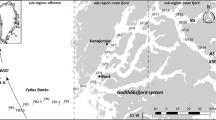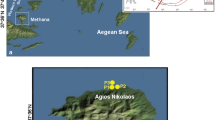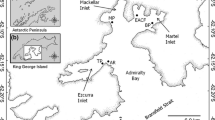Abstract
This paper presents the first comprehensive insight into the structure of planktonic communities, from nanoprotists to mesozooplankton in the waters north of Svalbard during the dark Arctic winter. Our investigations were carried out in two contrasting locations comparing a shallow fjord, Rijpfjorden, and a deep ice-covered region, Sofiadjupet, in January 2012. They revealed low chlorophyll a concentrations (<0.05 mg m−2), as a result of the low protist biomass (0.54–2.04 mg C m−2). Overall, 27 plastidic protist taxa were observed including 14 autotrophic taxa and one typical early Arctic spring bloom species (Entomoneis sp.). The presence of these phototrophic organisms, mostly dinoflagellates, showed that some pelagic autotrophs are able to survive the dark winter period. The high mesozooplankton biomass (6–8 g C m−2) indicated a healthy community despite the scarcity of primary producers. Three Calanus species dominated the mesoplanktonic biomass (79 %) in Rijpfjorden, whereas in Sofiadjupet carnivorous Chaetognatha (72 %) were dominant. Vertical distribution/profiles of the different trophic categories showed that herbivores were concentrated in the surface water layers (20–0 and 100–10 m) at both sites, whereas predators were occupying the deeper waters (600–100 m) of Sofiadjupet. Our results indicate that high mesozooplankton biomass is concentrated in surface waters. This contradicts the paradigm that mid-January, Arctic zooplankton communities overwinter in deep waters in a dormant state. Moreover, this work fills an evident gap in existing knowledge of Arctic plankton standing stocks and the relationships between its various size fractions during the polar night.







Similar content being viewed by others
References
Acker JG, Leptoukh G (2007) Online analysis enhances use of NASA earth science data. EOS Trans Am Geophys Union 88:14. doi:10.1029/2007EO020003
Alldredge AL, Madin LP (1982) Pelagic tunicates: unique herbivores in the marine plankton. Bioscience 32:655–663. doi:10.2307/1308815
Ambrose WG, Carroll ML, Greenacre M, Thorrold SR, Mcmahon KW (2006) Variation in Serripes groenlandicus (Bivalvia) growth in a Norwegian high-Arctic fjord: evidence for local- and large-scale climatic forcing. Glob Change Biol 12:1595–1607. doi:10.1111/j.1365-2486.2006.01181.x
Arashkevich EG, Kosobokova KN (1988) To the problem of life-strategy of herbivorous copepods: physiology and biochemical composition of the overwintering Calanus glacialis in starvation conditions. Oceanology 28:513–517
Arashkevich E, Wassmann P, Pasternak A, Wexels Riser C (2002) Seasonal and spatial changes in biomass, structure, and development progress of the zooplankton community in the Barents Sea. J Mar Syst 38:125–145. doi:10.1016/S0924-7963(02)00173-2
Arnkværn G, Daase M, Eiane K (2005) Dynamics of coexisting Calanus finmarchicus, Calanus glacialis and Calanus hyperboreus populations in a high-Arctic fjord. Polar Biol 28:528–538. doi:10.1007/s00300-005-0715-8
Ashjian CJ, Campbell RG, Welch HE, Butler M, Keuren DV (2003) Annual cycle in abundance, distribution, and size in relation to hydrography of important copepod species in the western Arctic Ocean. Deep Sea Res Part I 50:1235–1261. doi:10.1016/S0967-0637(03)00129-8
Bachy C, López-García P, Vereshchaka A, Moreira D (2011) Diversity and vertical distribution of microbial eukaryotes in the snow, sea ice and seawater near the North Pole at the end of the polar night. Front Microbiol 2:106. doi:10.3389/fmicb.2011.00106
Berestovskij EG, Anisimova NA, Denisenko CG, Luppowa EN, Savinov VM, Timofeev CF (1989) Relationship between size and body mass of some invertebrates and fish of the north-east Atlantic. Academy of Sciences of the USSR, Murman Marine Biological Institute, Apatity
Berge J, Cottier F, Last KS et al (2009) Diel vertical migration of Arctic zooplankton during the polar night. Biol Lett 5:69–72. doi:10.1098/rsbl.2008.0484
Berge J, Båtnes AS, Johnsen G, Blackwell SM, Moline MA (2012) Bioluminescence in the high Arctic during the polar night. Mar Biol 159:231–237
Blachowiak-Samolyk K, Kwasniewski S, Dmoch K, Hop H, Falk-Petersen S (2007) Trophic structure of zooplankton in the Fram Strait in spring and autumn 2003. Deep Sea Res Part II 54:2716–2728. doi:10.1016/j.dsr2.2007.08.004
Blachowiak-Samolyk K, Søreide JE, Kwasniewski S, Sundfjord A, Hop H, Falk-Petersen S, Hegseth EN (2008) Hydrodynamic control of mesozooplankton abundance and biomass in northern Svalbard waters (79–81 N). Deep Sea Res Part II 55:2210–2224. doi:10.1016/j.dsr2.2008.05.018
Brown TA, Hegseth EN, Belt ST (2013) A biomarker-based investigation of the mid-winter ecosystem in Rijpfjorden, Svalbard. Polar Biol. doi:10.1007/s00300-013-1352-2
Bunt JS, Lee CC (1972) Data on the composition and dark survival of four sea-ice microalgae. Limnol Oceanogr 17:458–461
Bursa A (1963) Phytoplankton in coastal waters of the Arctic Ocean at Point Barrow, Alaska. Arctic 16:239–262
Chislenko LL (1968) Nomograms for determination of the weight of aquatic organisms from body size and shape (marine mesobenthos and plankton). Nauka, Leningrad, pp 1–106 (in Russian)
Clarke A (1988) Seasonality in the Antarctic marine environment. Comp Biochem Physiol Part B 90:461–473
Conover RJ (1988) Comparative life histories in the genera Calanus and Neocalanus in high latitudes of the northern hemisphere. Hydrobiology 167(168):127–142
Conover RJ, Siferd TD (1993) Dark-season survival strategies for coastal zone zooplankton in the Canadian Arctic. Arctic 46:303–311. doi:10.14430/arctic1357
Daase M, Falk-Petersen S, Leu E, Wold A, Hop H, Varpe Ø, Søreide J, Berge J, Benoit P, Darnis G, Fortier L (2013) Plasticity in timing of reproductive events in Calanus glacialis: a Pan-Arctic perspective. Can J Fish Aquat Sci 70:871–884. doi:10.1139/cjfas-2012-0401
Edler L (1979) Recommendations on methods for marine biological studies in the Baltic Sea. Balt Mar Biolog Publ, Phytoplankton and chlorophyll 5
Eilertsen HC, Degerlund M (2010) Phytoplankton and light during the northern high-latitude winter. J Plankton Res 32:899–912
Eilertsen HC, Sandberg S, Tollefsen H (1995) Photoperiodic control of diatom spore growth—a theory to explain the onset of phytoplankton blooms. Mar Ecol Prog Ser 116:303–307
Falkenhaug T, Tande K, Timonin A (1997) Spatio-temporal patterns in the copepod community in Malangen, northern Norway. J Plankton Res 19:449–468. doi:10.1093/plankt/19.4.449
Falk-Petersen S, Sargent JR, Hopkins CCE (1990) Trophic relationships in the pelagic arctic food web. In: Barnes M, Gibson RN (eds) Trophic relationships in the marine environment. Scotland University Press, Aberdeen, pp 315–333
Falk-Petersen S, Hagen W, Kattner G, Clarke A, Sargent J (2000) Lipids, trophic relationships, and biodiversity in Arctic and Antarctic krill. Can J Fish Aquat Sci 57:178–191. doi:10.1139/f00-194
Falk-Petersen S, Timofeev S, Pavlov V, Sargent JR (2007) Climate variability and the effect on Arctic food chains. The role of Calanus. In: Ørbæk JR, Tombre T, Kallenborn R, Hegseth E, Falk-Petersen S, Hoel AH (eds) Arctic-alpine ecosystems and people in a changing environment. Springer, Berlin, pp 147–166
Falk-Petersen S, Mayzaud P, Kattner G, Sargent J (2009) Lipids and life strategy of Arctic Calanus. Mar Biol Res 5:18–39. doi:10.1080/17451000802512267
Falk-Petersen S, Pavlov V, Cottier F, Berge J, Kovacs KM, Lydersen C (2014) At the rainbow’s end—productivity hotspots due to upwelling along Arctic shelves. Polar Biol. doi:10.1007/s00300-014-1482-1
Garrison DL (1991) Antarctic sea ice biota. Am Zool 31:17–33. doi:10.1093/icb/31.1.17
Grainger EH (1959) The annual oceanographic cycle at Igloolik in the Canadian Arctic. 1. The zooplankton and physical and chemical observations. J Fish Res Board Can 16:453–501. doi:10.1139/f59-039
Hagen W, Auel H (2001) Seasonal adaptations and the role of lipids in oceanic zooplankton. Zoology 104:313–326. doi:10.1078/0944-2006-00037
Hanssen H (1997) Mesozooplankton of the Laptev Sea and the adjacent eastern Nansen Basin-distribution and community structure in late summer. Rep Polar Res 229:1–131
Harris R, Wiebe P, Lenz J, Skjoldal HR, Huntley M (eds) (2000) ICES zooplankton methodology manual. Academic Press, Waltham, 684 pp
Hassel (1986) Seasonal changes in zooplankton composition in the Barents Sea, with special attention to Calanus spp. (Copepoda). J Plankton Res 8:329–339. doi:10.1093/plankt/8.2.329
Head EJ, Conover RJ (1983) Induction of digestive enzymes in Calanus hyperboreus. Mar Biol Lett 4:219–231
Hegseth EN (1997) Phytoplankton of the Barents Sea-the end of a growth season. Polar Biol 17:235–241
Hegseth EN (1998) Primary production of the northern Barents Sea. Polar Res 17:113–123. doi:10.1111/j.1751-8369.1998.tb00266.x
Hegseth EN, Svendsen H, von Quillfeldt CH (1995) Phytoplankton in fjords and coastal waters of northern Norway: environmental conditions and dynamics of the spring bloom. In: Skjoldal HR, Hopkins C, Erikstad KE, Leinaas HP (eds) Ecology of fjords and coastal waters. Elsevier Science BV, Amsterdam, pp 45–72
Hirche HJ (1989) Spatial-distribution of digestive enzyme-activities of Calanus finmarchicus and Calanus hyperboreus in Fram Strait Greenland Sea. J Plankton Res 11:431–443. doi:10.1093/plankt/11.3.431
Hirche HJ (1991) Distribution of dominant calanoid copepod species in the Greenland Sea during late fall. Polar Biol 11:351–362
Hirche HJ, Kosobokova KN (2011) Winter studies on zooplankton in Arctic seas: the Storfjord (Svalbard) and adjacent ice-covered Barents Sea. Mar Biol 158:2359–2376. doi:10.1007/s00227-011-1740-5
Hirche HJ, Kosobokova KN, Gaye-Haake B, Harm L, Meon B, Nöthig E-M (2006) Structure and function of contemporary food webs on Arctic shelves: a panarctic comparison: the pelagic system of the Kara Sea—communities and components of carbon flow. Prog Oceanogr 71:288–313. doi:10.1016/j.pocean.2006.09.010
Holm-Hansen O, Riemann B (1978) Chlorophyll a determination: improvements in methodology. Oikos 30:438–447
Hopkins TL (1969) Zooplankton standing crop in the Arctic Basin. Limnol Oceanogr 14:80–85
Iversen KR, Seuthe L (2011) Seasonal microbial processes in a high-latitude fjord (Kongsfjorden, Svalbard): I. Heterotrophic bacteria, picoplankton and nanoflagellates. Polar Biol 34:731–749
Karnovsky NJ, Kwasniewski S, Weslawski JM, Walkusz W, Beszczynska-Möller A (2003) Foraging behaviour of little auks in a heterogeneous environment. Mar Ecol Prog Ser 253:289–303
Kosobokova KN, Hopcroft RR (2010) Diversity and vertical distribution of mesozooplankton in the Arctic’s Canada Basin. Deep Sea Res Part II 57:96–110. doi:10.1016/j.dsr2.2009.08.009
Kosobokova KN, Pertsova NM (2005) Zooplankton of the deep-water part of the white sea at the end of the hydrological winter. Oceanology 45:819–831
Kosobokova KN, Hanssen H, Hirche HJ, Knickmeier K (1998) Composition and distribution of zooplankton in the Laptev Sea and adjacent Nansen Basin during summer, 1993. Polar Biol 19:63–76. doi:10.1007/s003000050216
Kraft A, Berge J, Varpe Ø, Falk-Petersen S (2013) Feeding in Arctic darkness: mid-winter diet of the pelagic amphipods Themisto abyssorum and T. libellula. Mar Biol 160:241–248. doi:10.1007/s00227-012-2065-8
Kwasniewski S, Hop H, Falk-Petersen S, Pedersen G (2003) Distribution of Calanus species in Kongsfjorden, a glacial fjord in Svalbard. J Plankton Res 25:1–20. doi:10.1093/plankt/25.1.1
Leu E, Søreide JE, Hessen DO, Falk-Petersen S, Berge J (2011) Consequences of changing sea-ice cover for primary and secondary producers in the European Arctic shelf seas: timing, quantity, and quality. Prog Oceanogr 90:18–32. doi:10.1016/j.pocean.2011.02.004
Lewis J, Harris ASD, Jones KJ, Edmonds RL (1999) Long-term survival of marine planktonic diatoms and dinoflagellates in stored sediment samples. J Plankton Res 21:343–354. doi:10.1093/plankt/21.2.343
Lind S, Ingvaldsen RB (2012) Variability and impacts of Atlantic Water entering the Barents Sea from the north. Deep Sea Res Part I 62:70–88. doi:10.1016/j.dsr.2011.12.007
Lischka S, Hagen W (2005) Life histories of the copepods Pseudocalanus minutus, P. acuspes (Calanoida) and Oithona similis (Cyclopoida) in the Arctic Kongsfjorden (Svalbard). Polar Biol 28(12):910–921. doi:10.1007/s00300-005-0017-1
Lischka S, Hagen W (2007) Seasonal lipid dynamics of the copepods Pseudocalanus minutus (Calanoida) and Oithona similis (Cyclopoida) in the Arctic Kongsfjorden (Svalbard). Mar Biol 150(3):443–454
Lischka S, Gimenez L, Hagen W, Ueberschar B (2007) Seasonal changes in digestive enzyme (trypsin) activity of the copepods Pseudocalanus minutus (Calanoida) and Oithona similis (Cyclopoida) in the Arctic Kongsfjorden (Svalbard). Polar Biol 30:1331–1341
Lund JWG, Kipling C, Cren ED (1958) The inverted microscope method of estimating algal numbers and the statistical basis of estimations by counting. Hydrobiologia 11:143–170
Manley TO (1995) Branching of atlantic water within the Greenland–Spitsbergen passage: an estimate of recirculation. J Geophys Res 100:20627–20634
Mauchline J (1998) The biology of calanoid copepods. Advances in marine biology 33. Elsevier Academic Press, New York, pp 1–710
Menden-Deuer S, Lessard EJ (2000) Carbon to volume relationships for dinoflagellates, diatoms, and other protist plankton. Limnol Oceanogr 45:569–579
Mumm N (1991) On the summer distribution of mesozooplankton in the Nansen Basin, Arctic Ocean. Rep Polar Res 92:1–146
Niemi A, Michel C, Hille K, Poulin M (2011) Protist assemblages in winter sea ice: setting the stage for the spring ice algal bloom. Polar Biol 34:1803–1817
Paffenhöfer GA (1988) Feeding rates and behavior of zooplankton. Bull Mar Sci 43:430–444
Paffenhöfer GA (1993) On the ecology of marine cyclopoid copepods (Crustacea, Copepoda). J Plankton Res 15:37–55
Palmisano AC, Sullivan CW (1983) Physiology of sea ice diatoms. II. Dark survival of three polar diatoms. Can J Microbiol 29:157–160
Percy JA (1989) Abundance, biomass, and size frequency distribution of an arctic ctenophore, Mertensia ovum (Fabricius) from Frobisher Bay, Canada. Sarsia 74:95–105
Piepenburg D (2005) Recent research on Arctic benthos: common notions need to be revised. Polar Biol 28:733–755
Pond DW, Tarling GA (2011) Phase transitions of wax esters adjust buoyancy in diapausing. Calanoides acutus. Limnol Oceanogr 56:1310–1318
Rabindranath A, Daase M, Falk-Petersen S, Wold A, Wallace MI, Berge J, Brierly AS (2011) Seasonal and diel vertical migration of zooplankton in the High Arctic during the autumn midnight sun of 2008. Mar Biodiv 41:365–382
Richter C (1994) Regional and seasonal variability in the vertical distribution of mesozooplankton in the Greenland Sea. Rep Polar Res 154:1–90
Różańska M, Gosselin M, Poulin M, Wiktor JM, Michel C (2009) Influence of environmental factors on the development of bottom ice protist communities during the winter–spring transition. Mar Ecol Prog Ser 386:43–59
Rudels B, Friedrich HJ, Quadfasel D (1999) The arctic circumpolar boundary current. Deep Sea Res Part II 46:1023–1062
Saloranta TM, Haugan PM (2001) Interannual variability in the hydrography of Atlantic water northwest of Svalbard. J Geophys Res 106:931–943
Sargent JR, Henderson RJ (1986) Lipids. In: Corner EDS, O’hara SCM (eds) The biological chemistry of marine copepods. University Press, Oxford, pp 59–108
Seiler D, Brandt A (1997) Seasonal occurrence of planktic Crustacea in sediment trap samples at three depth horizons in the Greenland Sea. Polar Biol 17:337–349
Smayda TJ, Mitchell-Innes B (1974) Dark survival of autotrophic, planktonic marine diatoms. Mar Biol 25:195–202
Smetacek V, Nicol S (2005) Polar ocean ecosystems in a changing world. Nature 437:362–368
Søreide JE, Hop H, Falk-Petersen S, Gulliksen B, Hansen E (2003) Macrozooplankton communities and environmental variables in the Barents Sea marginal ice zone in late winter and spring. Mar Ecol Prog Ser 263:43–64
Søreide JE, Falk-Petersen S, Hegseth EN, Hop H, Carroll ML, Hobson KA, Blachowiak-Samolyk K (2008) Seasonal feeding strategies of Calanus in the high-Arctic Svalbard region. Deep Sea Res Part II 55:2225–2244
Søreide JE, Leu E, Berge J, Graeve M, Falk-Petersen S (2010) Timing of blooms, algal food quality and Calanus glacialis reproduction and growth in a changing Arctic. Glob Change Biol 16:3154–3163
Stromberg JO (1989) Northern Svalbard waters. In: Proceedings of the sixth conference of the Comité Arctique international. Brill Academic Publishers, pp 1–402
Tande KS (1991) Calanus in North Norwegian fjords and in the Barents Sea. Polar Res 10:389–407
Tande K, Slagstad D (1982) Ecological investigation on the zooplankton community of Balsfjorden, Northern Norway—Seasonal and short time variations in enzyme activity in copepodite stage V and VI males and females of Calanus finmarchicus (Gunnerus). Sarsia 67:63–68
Turner JT, Levinsen H, Nielsen TG, Hansen BW (2001) Zooplankton feeding ecology: grazing on phytoplankton and predation on protozoans by copepod and barnacle nauplii in Disko Bay, West Greenland. Mar Ecol Prog Ser 221:209–219
Ussing HH (1938) The biology of some important plankton animals in the fjords of East Greenland. Dissertation, I Kommission hos CA Reitzels forlag
Utermöhl H (1958) Zur vervollkommnung der quantitativen phytoplankton-methodik. Mitt Int Ver Limnol 9:1–38
Uye SI (1982) Length-weight relationships of important zooplankton from the Inland Sea of Japan. J Oceanogr 38:149–158
Walczowski W, Piechura J (2007) Pathways of the Greenland Sea warming. Geophys Res Lett 34:L10608
Walczowski W, Piechura J, Osinski R, Wieczorek P (2005) The West Spitsbergen Current volume and heat transport from synoptic observations in summer. Deep Sea Res Part I 52:1374–1391
Wallace MI, Cottier FR, Berge J, Tarling GA, Griffiths C, Brierley AS (2010) Comparison of zooplankton vertical migration in an ice-free and a seasonally ice-covered Arctic fjord: an insight into the influence of sea ice cover on zooplankton behavior. Limnol Oceanogr 55:831–845
Weslawski JM, Kwasniewski S, Wiktor J (1991) Winter in a Svalbard Fiord Ecosystem. Arctic 44:115–123
Wiebe PH, Boyd SH, Cox JL (1975) Relationships between zooplankton displacement volume, wet weight, dry weight, and carbon. Fish Bull US 73:777–786
Wiktor J (1999) Early spring microplankton development under fast ice covered fjords of Svalbard, Arctic. Oceanologia 41:51–72
Wold A, Darnis G, Søreide JE, Leu E, Philippe B, Fortier L, Poulin M, Kattner G, Graeve M, Falk-Petersen S (2011) Life strategy and diet of Calanus glacialis during the winter-spring transition in Amundsen Gulf, southeast Beaufort Sea (Arctic Ocean). Polar Biol 34:1929–1946
Acknowledgments
We are indebted to the captain and crew of the R/V Helmer Hanssen for their assistance in field. This project was supported by Norwegian Research Council (CLEOPATRA II and CircA), Polish Scientific Council (658/W-HAUSGARTEN/2010/0), Polish National Scientific Centre (2736/UniPlankton/2013) and IOPAS statutory activity. The authors would like also to acknowledge the Arctic marine ecosystem research network (ARCTOS) for supporting a participation of PhD student—Anna Kubiszyn in the Polar Night Cruise (ARCTOS-BIO-8510). Gunilla Eriksen at Tromsø University is thanked for her contribution to cell counting. Additionally, we acknowledge the MODIS mission scientists and associated NASA personnel for the production of the data used in this research for drawing Fig. 1. We are sincerely indebted to Martin Angel (National Oceanographic Centre, Southampton) and Clare Webster (University of St. Andrew) for their valuable improvements to the text and English proof reading.
Author information
Authors and Affiliations
Corresponding author
Additional information
This article belongs to the special Polar Night issue, coordinated by Ole Jørgen Lønne.
Rights and permissions
About this article
Cite this article
Błachowiak-Samołyk, K., Wiktor, J.M., Hegseth, E.N. et al. Winter Tales: the dark side of planktonic life. Polar Biol 38, 23–36 (2015). https://doi.org/10.1007/s00300-014-1597-4
Received:
Revised:
Accepted:
Published:
Issue Date:
DOI: https://doi.org/10.1007/s00300-014-1597-4




